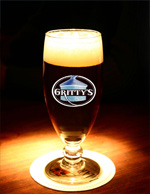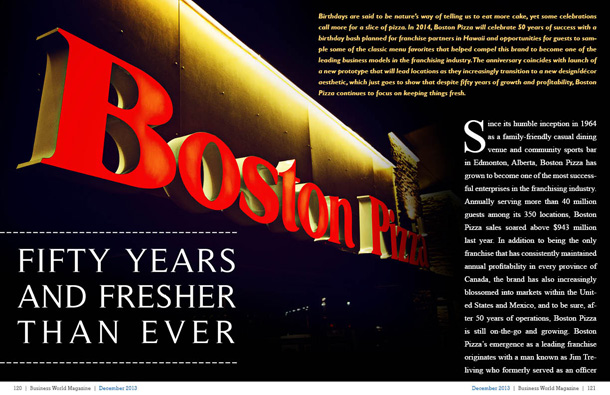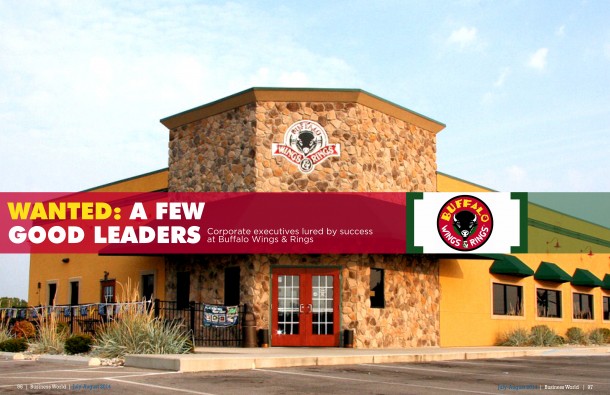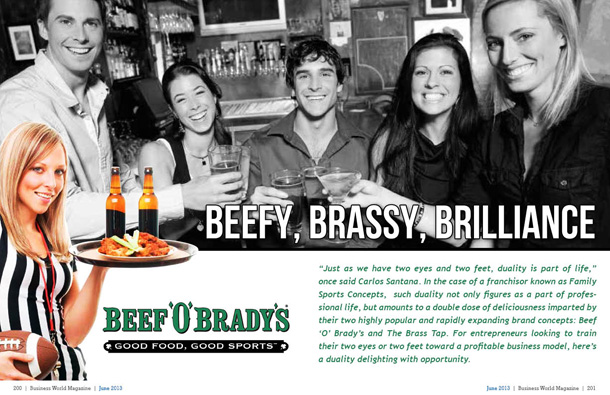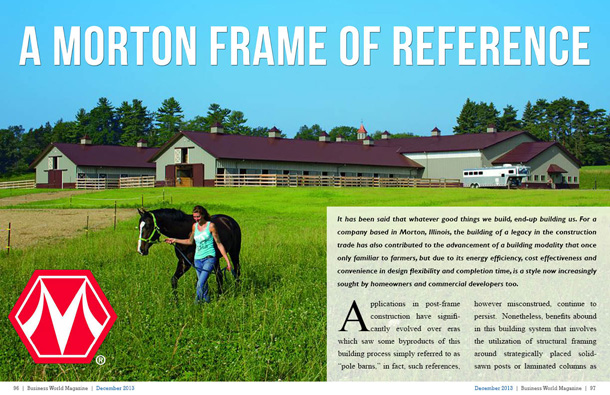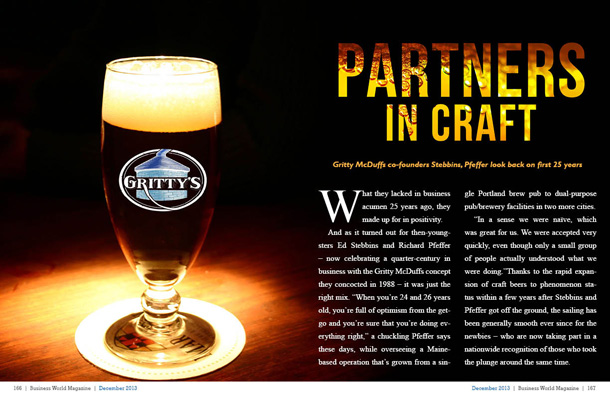
Partners in Craft
Gritty McDuffs co-founders Stebbins, Pfeffer look back on first 25 years
What they lacked in business acumen 25 years ago, they made up for in positivity.
And as it turned out for then-youngsters Ed Stebbins and Richard Pfeffer – now celebrating a quarter-century in business with the Gritty McDuffs concept they concocted in 1988 – it was just the right mix.
“When you’re 24 and 26 years old, you’re full of optimism from the get-go and you’re sure that you’re doing everything right,†a chuckling Pfeffer says these days, while overseeing a Maine-based operation that’s grown from a single Portland brew pub to dual-purpose pub/brewery facilities in two more cities.
“In a sense we were naïve, which was great for us. We were accepted very quickly, even though only a small group of people actually understood what we were doing.â€
Thanks to the rapid expansion of craft beers to phenomenon status within a few years after Stebbins and Pfeffer got off the ground, the sailing has been generally smooth ever since for the newbies – who are now taking part in a nationwide recognition of those who took the plunge around the same time.
CELEBRATING SUCCESS
A casual discussion at The Brewers Association’s annual Craft Brewers Conference a few years back was the genesis of the large-scale 25th anniversary fete, in which similarly-aged brewers at facilities across the country are traveling to their contemporaries’ businesses to serve as “guest brewers.â€
Stebbins made a trip to Portland, Ore. to play the part in early December, and Gritty McDuff’s hosted a brewer from a Vermont-based operation earlier in the year for the same endeavor.
Much of the time in the business’s fledgling years, Stebbins and Pfeffer recall, was spent educating the locals on the brew pub concept and convincing them of its legitimacy.
“Beer historians understood that there had always been local breweries all over America, and Europeans got it, too, because it’s a model they’ve always had. There they have always operated with small, local breweries,†Stebbins says. “In fact, most of our suppliers back then were European-based, because only a couple of people were working to supply small brewers. Most of the suppliers here, and across the country, were used to working with these huge amounts of product that we simply didn’t need.â€
A CHANGING MARKET
Ultimately, the small-scale brewing market began gathering momentum in a fashion similar to what people had already been seeing in the wine and specialty coffee segments.
What was good for Starbucks, Pfeffer says, was ultimately good for Gritty McDuffs as well.
“You saw it in the increased popularity of California wines. You saw it in the coffee industry with Starbucks. You saw it with Haagen-Dazs in ice cream,†he says. “People didn’t want mass-produced products anymore. Whatever the industry or the industry group, everyone was looking more toward quality and they wanted more than just Wonder Bread.
“That’s really the gist of it, but it still took a long time to develop and get to that level. Because of the infrastructure that existed, you had large brewers who had control over the majority of the wholesalers, so that created a struggle for any other smaller entities to get established.â€
And though the historical schematic was drawn without them in mind, the small-brewer framework did begin to take a tangible shape as more and more local operations sprung up.
From there, it was simple geometry, Stebbins says.
“There are 53 brewers in Portland, Ore. You go to another small town like Bend, which has about 80,000 people, and there are another 30 brewers. There are pockets of quality all across the country,†he says. “What we’ve reached now is a stage where we’re connecting the dots. It’s not just northern New England and the Pacific Northwest. You can get a quality-brewed craft beer pretty much anywhere.â€
Both Pfeffer and Stebbins concede they were too immersed in day-to-day operations in the early years to see the industry changes coming in advance, but once the products and concepts began taking hold they soon realized that expansion had to be in their plans as well.
Their facility in Freeport, about 16 miles north of the Portland location on Interstate 295, was opened when the realization was reached that useful space had been maxed out in the first location. The third location, in Auburn, is another 20 miles northwest of Freeport – off of state route 136.
“The signs were there, but we were too busy working as chief cooks and bottle washers to pay attention to them. It’s hard to cast your focus beyond what’s right in front of you at that stage,†Stebbins said. “But I always thought we’d grow, even if it’s been at a fairly slow pace compared to other businesses.â€
SIMILARLY UNIQUE
The locations themselves are modeled after old-school English-style public houses and the ideal atmosphere is one where people from all walks of life feel comfortable sharing a meal and a beverage.
And while that general concept is organization-wide, each location has developed a signature feel.
“Pubs traditionally tie into their communities, so rather than fitting the community to a pub it was our aim to fit the pub to the community,†Pfeffer says. “At Freeport, there’s an outside lawn and a playground, so it’s not unusual to see parents sitting on the deck while their kids are playing. It’s really an inviting spot for a family to come out.
“In Portland, you’re seeing a lot of business lunches, and in both Portland and Auburn there’s a nightlife crowd as well. The priority is the enjoyment of both the food and the beer, because it’s our view that you can’t enjoy a good beer unless you have some good food in front of you, too.â€
As for the future, the co-founders insist growth is on the agenda, but at the same measured pace that’s been a calling card for the initial 25 years.
“Ed and I go back and forth on that,†Pfeffer says. “When we decide to do something we do it as a mutual agreement, and things take longer because of that. My vision right now is to spend time getting better at what we do and getting the team as solid as it can be.
“We’ll keep our eyes open to opportunities as they present themselves. I’d certainly like to have a couple more pubs, and if the time is right we’ll probably go ahead and do it.â€
For more information, please visit their website at: Â Â Gritty McDuffs


